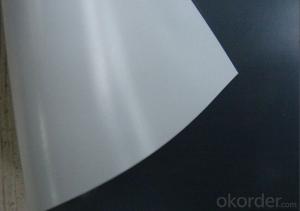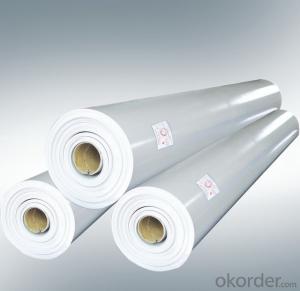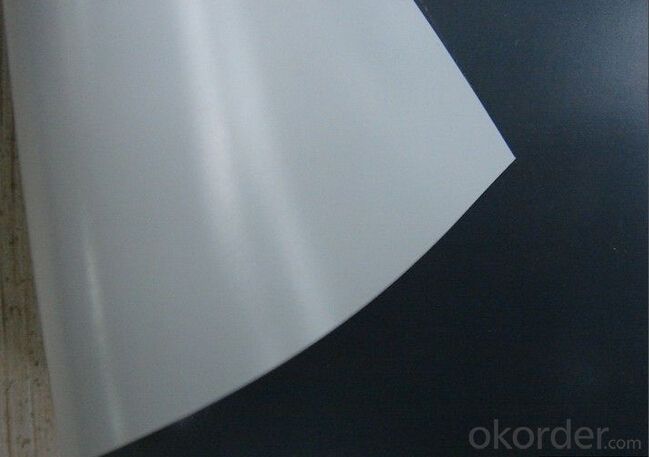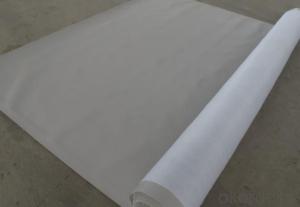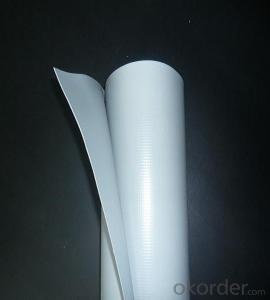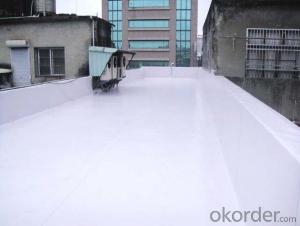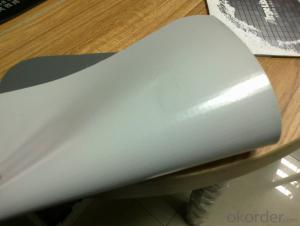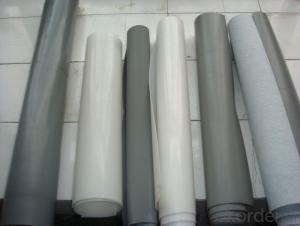Polyvinyl Chloride (PVC) Waterproofing Membrane Filter
- Loading Port:
- China main port
- Payment Terms:
- TT OR LC
- Min Order Qty:
- 5000 m²
- Supply Capability:
- 100000 m²/month
OKorder Service Pledge
OKorder Financial Service
You Might Also Like
The best quality PVC waterproof membrane in China
1. Features of PVC Waterproofing Membrane:
Excellent anti-aging property.
Puncture- resistant.
Welding construction,
High tensile strength, good elongation, good dimensional stability.
Good plasticity.
It has self-extinguishing from fire property.
Materials surface is smooth, fast color, stain resistance.
More wide, Wastage become less when being used.
2. Specification of PVC Waterproofing Membrane:
Item | Specification |
Length | 20m |
Width | 1.05m, 2.05m,2.1m |
Thickness | 0.8mm,1.0mm;1.2mm;1.5mm;2.0mm |
3. Type of PVC Waterproofing Membrane:
N1—Exposed PVC waterproof membrane.
(It is mainly used as details treatment for exposed roof waterproof project)
N2—Non-exposed PVC waterproof membrane.
(It is mainly used as details treatment for non-exposed roof waterproof project)
L1—Exposed PVC waterproof membrane with fabric.
(It is mainly used for exposed roof waterproof project)
L2—Non-exposed PVC waterproof membrane with fabric.
(It is mainly used for non-exposed roof waterproof project)
W1—Exposed reinforced PVC waterproof membrane .
(It is mainly used for steel structure roof exposed waterproof project)
W2—Exposed reinforced PVC waterproof membrane .
(It is mainly used for steel structure roof non-exposed waterproof project)
4. Use scope of PVC Waterproofing Membrane:
-All kinds of roof .eg steel structure roof, planted roof and so on.
-Underground engineering, such as building basement, subways, tunnels, air Raid shelter, etc.
-Other projects like artificial lake , dam, water reservoir,, grain storehouse, etc.
5. FAQ of PVC Waterproofing Membrane
a.Can we get some samples before place order?
Answer: We can send the free samples to you by freight collect.
b.How many years can your PVC membrane guarantee?
Answer: We will guarantee the quality for 5 years at least.
c.Which countries you ever export the product?
Answer: We export the PVC membrane to South Africa, Middle east and even European countries.
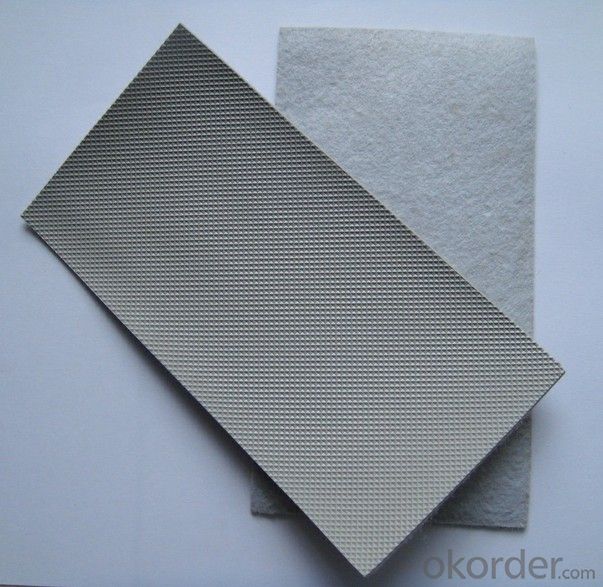
- Q: Can a waterproofing membrane be used for retaining walls?
- Yes, a waterproofing membrane can be used for retaining walls. Retaining walls are structures designed to hold back soil or water, and it is essential to prevent water penetration to avoid potential damage or structural failure. Waterproofing membranes are commonly used to provide a barrier against water infiltration, thereby protecting the retaining wall and ensuring its stability over time. These membranes are typically made of materials like rubber, PVC, or bituminous compounds, and they are installed on the inner side of the retaining wall to prevent water from seeping through. Additionally, some waterproofing membranes also offer additional benefits such as resistance to root penetration, UV protection, and flexibility to accommodate movement in the retaining wall. However, it is important to note that the specific type of waterproofing membrane used should be selected based on factors such as the type of retaining wall, the level of water pressure, and local climate conditions. Consulting with a professional engineer or contractor is recommended to ensure the appropriate waterproofing solution for your particular retaining wall project.
- Q: Are waterproofing membranes suitable for below-grade applications?
- Yes, waterproofing membranes are suitable for below-grade applications. Waterproofing membranes are specifically designed to prevent the infiltration of water into below-grade structures such as basements, foundations, and retaining walls. These membranes are made from durable materials that can withstand the pressure of soil and water, ensuring long-term protection against leaks and water damage. They are typically installed on the exterior side of the below-grade structure to create a barrier that prevents water from seeping through the walls or floors. Additionally, waterproofing membranes are flexible and can accommodate structural movements, ensuring their effectiveness even in challenging below-grade environments. Overall, waterproofing membranes are a reliable and effective solution for protecting below-grade structures from water intrusion.
- Q: Can a waterproofing membrane be used on roofs with rooftop gardens?
- Yes, a waterproofing membrane can be used on roofs with rooftop gardens. In fact, it is highly recommended to use a waterproofing membrane to protect the underlying structure from water damage. A rooftop garden adds additional weight and moisture to the roof, so a proper waterproofing system is essential to prevent leaks and ensure the longevity of the roof. The waterproofing membrane acts as a barrier against water infiltration and helps to keep the rooftop garden and the building below dry.
- Q: Can a waterproofing membrane be used for a podium deck coating?
- Yes, a waterproofing membrane can be used for a podium deck coating. The membrane is designed to prevent water penetration and provide a protective barrier, making it suitable for waterproofing applications such as podium deck coatings.
- Q: SBS Shale Waterproof Coil
- Classification: According to physical indicators are divided into: Ⅰ (-20 ℃), Ⅱ (-25 ℃) type two categories.
- Q: Are there any specific considerations for installing a waterproofing membrane on wood surfaces?
- Yes, there are several specific considerations for installing a waterproofing membrane on wood surfaces. Firstly, it is important to ensure that the wood surface is clean, dry, and free from any debris or loose material. This will help in achieving a proper adhesion of the waterproofing membrane. Additionally, it is crucial to choose a membrane specifically designed for wood surfaces, as they may require additional flexibility and resistance to expansion and contraction. It is also recommended to apply a primer or sealer to the wood surface before installing the membrane to improve its adhesion and longevity. Lastly, regular inspection and maintenance of the waterproofing membrane is essential to identify any potential issues and ensure its effectiveness over time.
- Q: Can a waterproofing membrane be used on terraces or patios?
- Terraces and patios can benefit greatly from the application of a waterproofing membrane. To avoid water damage and leakage, it is highly recommended to use this protective layer in these areas. Given that terraces and patios are exposed to different weather conditions, such as rain and snow, moisture can easily seep into the underlying structure. To counteract this issue, a waterproofing membrane acts as a barrier, preventing water from infiltrating the surface and safeguarding the integrity of the terrace or patio. This solution not only extends the lifespan of the structure but also prevents costly repairs in the future. Moreover, the use of a waterproofing membrane contributes to the creation of a more comfortable and functional space, as it eliminates the risk of water accumulation and potential slip hazards. All in all, investing in a high-quality waterproofing membrane is a wise choice for those seeking to protect their terrace or patio from water damage.
- Q: Can waterproofing membranes be applied over existing surfaces?
- Applying waterproofing membranes over existing surfaces is indeed a common practice in construction and renovation projects. These membranes serve as a protective barrier against water infiltration and can be used on various surfaces like concrete, wood, metal, or even other waterproofing systems. By applying a waterproofing membrane over an existing surface, it effectively prevents water damage such as leaks, mold growth, and structural deterioration. However, it is crucial to properly prepare and clean the existing surface before applying the membrane to ensure optimal adhesion and performance. It is also advisable to seek guidance from a professional waterproofing contractor to determine the most suitable membrane type and installation method for your specific project requirements.
- Q: Can a waterproofing membrane be used on stone block surfaces?
- Stone block surfaces can indeed benefit from the use of a waterproofing membrane. This particular membrane is specifically designed to create a protective barrier against water and moisture, making it suitable for application on various surfaces, including stone blocks. By acting as a barrier, this membrane effectively prevents water from seeping into the stone and causing detrimental effects such as cracking, spalling, or efflorescence. It offers valuable protection against water-related issues such as freeze-thaw damage and the growth of mold and mildew. Moreover, the application of a waterproofing membrane can significantly enhance the durability and longevity of stone blocks by shielding them from water damage. Consequently, it is highly recommended to utilize a waterproofing membrane on stone block surfaces to ensure their long-term integrity and aesthetics.
- Q: Are waterproofing membranes suitable for bridge abutments?
- Yes, waterproofing membranes are suitable for bridge abutments. Bridge abutments are the structures that support the ends of a bridge, and they are typically exposed to a significant amount of moisture and water. Waterproofing membranes are designed to provide a protective barrier against water and moisture intrusion, making them an ideal solution for bridge abutments. These membranes are typically made from materials such as bitumen, PVC, or EPDM, which are highly resistant to water penetration. Additionally, waterproofing membranes can also provide protection against other factors such as UV rays, chemicals, and temperature fluctuations. By installing waterproofing membranes on bridge abutments, the risk of water damage, deterioration, and corrosion can be significantly reduced, leading to increased durability and longevity of the bridge structure.
Send your message to us
Polyvinyl Chloride (PVC) Waterproofing Membrane Filter
- Loading Port:
- China main port
- Payment Terms:
- TT OR LC
- Min Order Qty:
- 5000 m²
- Supply Capability:
- 100000 m²/month
OKorder Service Pledge
OKorder Financial Service
Similar products
Hot products
Hot Searches
Related keywords
